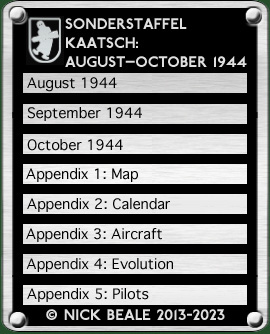|
During the retreat, airforce units have shown signs of serious indiscipline. It is requested that specially-authorised officers or Luftwaffe patrols are permitted to intervene energetically against this. Army Group G to Ob. West (19.00 hrs,) In their precipitate retreat from France, the German armed forces had become desperately disorganised and if a new defence line was to be established commanders must first find and then regain control of their troops as well as locate their opponents. At 0700 GMT, the Admiral for the French south coast, Vizeadmiral Ernst Scheurlen, reported that he had reached Chalon-sur-Saône, where Nineteenth Army had also arrived. He planned to establish his "final alternative quarters" in Besançon. On this day, OKL Operations Staff ordered FAG 123 (which had transferred from Reims to Luxembourg-Sandweiler four days previously) and II. Jagdkorps (which controlled Luftflotte 3’s fighters) to carry out “extensive reconnaissance operations to help clarify the situation.” These should take place: … over concentration areas, the gap between Army Group B and Army Group G and also over the main enemy wedges. In additions, the situation of German forces must also be frequently reconnoitred, especially in the case of units which have been cut off. It is stressed that all reports must be sent to the Army HQ authorities responsible and to OKL Operations Staff as quickly as possible. Tactical reconnaissance capability in the West was still being reconstituted and on the 1st, 5.(F)/123 took over Bf 109 G-6, W.Nr. 780692 from 4.(F)/123: this aircraft had methanol-water injection and was armed with an MG 151/20 and two MG 131 but had no log for the engine or airframe and its log-book was missing. The weather prevented Staffel Kaatsch from completing a reconnaissance from Dijon to Avallon, Cosne and Chateauneuf sur Loire; no traffic was observed during the flight. During the day OKL ordered FAG 123 and II. Jagdkorps that, on account of the eupemistically-described “rapid development of the situation in the West” necessitated a ontribution “on an exceptional scale” from Luftflotte 3, to clarify the situation by reconnaissance. This must cover in particular the main concentrations force in the gap between Army Groups B and G as well as the principal enemy spearheads. It would also often be necessary to report on the German situation, not least the whereabouts of units that had been cut off, and all reports must be forwarded to the army authorities and OKL with the utmost dispatch. Listed as »Aufkl. Staffel Kaatsch (aus JG 200)« — i.e. “formed from JG 200” — the Staffel was credited with a strength of 16 x Bf 109 G-6 on 1 September.
An Oblt. Popp reported to Maj. Kaatsch that nowhere around Luxeuil-Malbouhen, Belfort and Mulhouse was suitable (presumably as a base for the unit) and asked for further instructions, adding that he was at Luxeuil airfield and awaiting the return of Ltn. Harbert who had been delayed by the weather.
During the morning Sonderstaffel Kaatsch notified FAG 123 and Luftflotte 3’s Chief Quartermaster that it was transferring from Dijon to Luxeuil-les-Bains and would need a Ju 52 that night and the next for the purpose (two days earlier a message from Geschwader Bongart had said that Luxeuil was “being prepared for destruction”). The move had been ordered that day by Lfl. 3 but in the event it would be another eight days before Dijon was liberated by the 2e Régiment de Chassuers d'Afrique. At 16.10 hrs. Ltn. Bell claimed an Auster III shot down, 1 km. north of “Tessains”, identified by Jochen Prien as Jessains, 38 kms east of Troyes, in the Aube départment. This was on the line of advance of the US Third Army so the victim is more likely to have been a USAAF Taylorcraft, Stinson or Piper rather than the Auster which was a British development of a US design. Heinz Moschke took off (this time in “2”) five minutes after Bell’s victory and landed in Dijon at 18.06 hours.
Army Group G reported that air reconnaissance for 19th Army that afternoon had seen: 17.00 hrs: 25 lorries from St. Florentin to Tonnerre. Immediately south east of St. Florentin, 100 six-man tents. 18.30 hrs: enemy tank spearhead with 10–12 tanks and 20–25 lorries 5 km north of Gex. Heading for Morez. The first of these flights appears to be Bell’s, the second Moschke’s: St. Florentin and Tonnerre are around 110 and 125 km respectively to the north west of Dijon; the Gex–Morez road about 125 km to the south east, close to the Swiss border. According to statistics compiled by the Quartermaster General, the Staffel posted two aircraft missing on operations and another destroyed by Flak. A Field Intelligence Unit examining Dijon later in the month reported that “it was used by the Germans up to about 8th Sept 1944” but none of the wrecks they recorded there appears to have belonged to Staffel Kaatsch.
At 09.45 hrs. Luftflotte 3 gave orders for the transfer of 5.(F)/123 from Trier-Euren to Hagenau and Staffel Kaatsch to Luxeuil (Kaatsch had already received the same order the previous day (see above). Luftlotte Reich was urged to give priority to supplies and quarters for the elements of FAG 123 that were transferring “since all reconnaissance in the West depends on [this Gruppe’s] operations.” This parting of the ways makes it easier to distinguish between the activities of Kaatsch and 5.(F)/123 from here on. Leutnant Moschke flew a 65-minute mission from Dijon, taking off at 08.57 hours. Army Group G’s reported that at 13.30 hours a column of 10–12 enemy tanks and 50–60 lorries was 20 km south west of Pontarlier but the source of this information is not recorded. continued on next page …
|
|||||||||
TIMELINE |
|
1 September |
US forces take Verdun. |
2 September |
US Third Army immobilised after outrunning fuel supplies. |
3 September |
British troops enter Brussels; French and US troops enter Lyon. |


